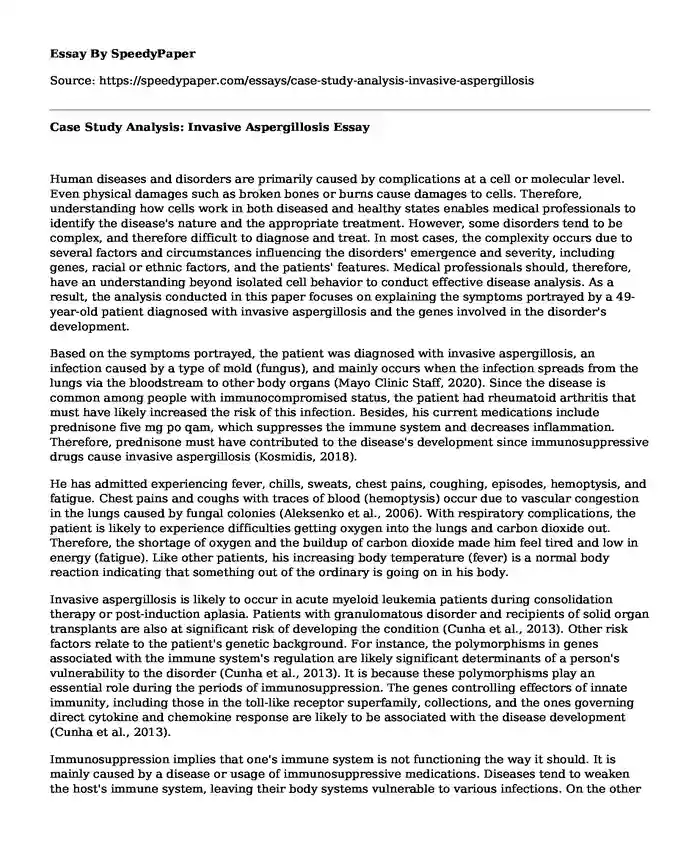
| Type of paper: | Case study |
| Categories: | Medicine Healthcare |
| Pages: | 3 |
| Wordcount: | 689 words |
Human diseases and disorders are primarily caused by complications at a cell or molecular level. Even physical damages such as broken bones or burns cause damages to cells. Therefore, understanding how cells work in both diseased and healthy states enables medical professionals to identify the disease's nature and the appropriate treatment. However, some disorders tend to be complex, and therefore difficult to diagnose and treat. In most cases, the complexity occurs due to several factors and circumstances influencing the disorders' emergence and severity, including genes, racial or ethnic factors, and the patients' features. Medical professionals should, therefore, have an understanding beyond isolated cell behavior to conduct effective disease analysis. As a result, the analysis conducted in this paper focuses on explaining the symptoms portrayed by a 49-year-old patient diagnosed with invasive aspergillosis and the genes involved in the disorder's development.
Based on the symptoms portrayed, the patient was diagnosed with invasive aspergillosis, an infection caused by a type of mold (fungus), and mainly occurs when the infection spreads from the lungs via the bloodstream to other body organs (Mayo Clinic Staff, 2020). Since the disease is common among people with immunocompromised status, the patient had rheumatoid arthritis that must have likely increased the risk of this infection. Besides, his current medications include prednisone five mg po qam, which suppresses the immune system and decreases inflammation. Therefore, prednisone must have contributed to the disease's development since immunosuppressive drugs cause invasive aspergillosis (Kosmidis, 2018).
He has admitted experiencing fever, chills, sweats, chest pains, coughing, episodes, hemoptysis, and fatigue. Chest pains and coughs with traces of blood (hemoptysis) occur due to vascular congestion in the lungs caused by fungal colonies (Aleksenko et al., 2006). With respiratory complications, the patient is likely to experience difficulties getting oxygen into the lungs and carbon dioxide out. Therefore, the shortage of oxygen and the buildup of carbon dioxide made him feel tired and low in energy (fatigue). Like other patients, his increasing body temperature (fever) is a normal body reaction indicating that something out of the ordinary is going on in his body.
Invasive aspergillosis is likely to occur in acute myeloid leukemia patients during consolidation therapy or post-induction aplasia. Patients with granulomatous disorder and recipients of solid organ transplants are also at significant risk of developing the condition (Cunha et al., 2013). Other risk factors relate to the patient's genetic background. For instance, the polymorphisms in genes associated with the immune system's regulation are likely significant determinants of a person's vulnerability to the disorder (Cunha et al., 2013). It is because these polymorphisms play an essential role during the periods of immunosuppression. The genes controlling effectors of innate immunity, including those in the toll-like receptor superfamily, collections, and the ones governing direct cytokine and chemokine response are likely to be associated with the disease development (Cunha et al., 2013).
Immunosuppression implies that one's immune system is not functioning the way it should. It is mainly caused by a disease or usage of immunosuppressive medications. Diseases tend to weaken the host's immune system, leaving their body systems vulnerable to various infections. On the other end, immunosuppressant drugs also suppress or reduce the body's ability to fight pathogens. Despite being used to treat some diseases and prepare patients for an organ transplant, using these medications can cause adverse effects to the patient's body systems. For instance, high impact immunosuppressive agents such as steroids and calcineurin inhibitors are linked to several devastating metabolic impacts (Bamgbola, 2016). They include hypertension, dyslipidemia, and potential for long term cardiovascular problems.
References
Aleksenko, A., Gyasi, R., & Gyasi, R. (2006). Disseminated invasive aspergillosis. Ghana Medical Journal, 40(2). https://doi.org/10.4314/gmj.v40i2.36021
Bamgbola, O. (2016). Metabolic consequences of modern immunosuppressive agents in solid organ transplantation. Therapeutic Advances in Endocrinology and Metabolism, 7(3), 110–127. https://doi.org/10.1177/2042018816641580
Cunha, C., Aversa, F., Romani, L., & Carvalho, A. (2013). Human Genetic Susceptibility to Invasive Aspergillosis. PLoS Pathogens, 9(8), e1003434. https://doi.org/10.1371/journal.ppat.1003434
Kosmidis, C. (2018). Aspergillosis. NORD (National Organization for Rare Disorders). https://rarediseases.org/rare-diseases/aspergillosis/#symptoms
Mayo Clinic Staff. (2020, February 5). Aspergillosis - symptoms, and causes. Mayo Clinic. https://www.mayoclinic.org/diseases-conditions/aspergillosis/symptoms-causes/syc-20369619
Cite this page
Case Study Analysis: Invasive Aspergillosis. (2024, Jan 26). Retrieved from https://speedypaper.net/essays/case-study-analysis-invasive-aspergillosis
Request Removal
If you are the original author of this essay and no longer wish to have it published on the SpeedyPaper website, please click below to request its removal:
- Essay Sample on Dignity and Meaning through Nursing
- Performance-Enhancing Drugs in Sports, Essay Sample for Free
- Free Essay: Comprehensive Health Assessment of a Geriatric Patient
- Essay Sample: Pharmacological Effects of Amiodarone in the Management of Arrhythmias and Nursing Implications
- Unmet Needs for Management of HIV & TB - Essay Sample
- Attention-Getter/hook. Free Essay Example
- Paper Sample on Post COVID-19 Life
Popular categories




